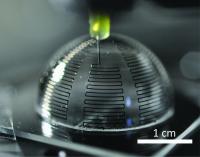Jennifer T. Bernhard, professor of electrical and computer engineering at the University of Illinois at Urbana-Champaign says that of late, antennae have been developed through screen printing, inkjet printing, and microfluidics filled with liquid metal in simple patterns, including dipoles and loops.
But these methods display limitations in spatial resolution and dimensionality. This leads to planar antennae taking up more space in relation to actual performance. Omni directional printing of metallic nanoparticle inks can be used instead of the demanding footprints of the three dimensional electrically small antennae (ESAs).
 Antenna during Printing process
Antenna during Printing process
Bernhard says the antennae are electrically compact in relation to a wavelength and display high performance. Printing directly on to the hemispherical material helped the research team to develop a single-mode antenna with a Q that almost matches the basic limit set by physics known as the Chu limit. The antenna's movement is printed either on the outside or inside of the hemispherical materials, making it more flexible. The surface normal keeps shifting on curvilinear surfaces, making fabrication difficult. In order to conformally print features on the hemispherical materials, the silver ink needs to moisturize the surface to ease designing.
The antenna should tolerate mechanical handling. The silver nanoparticle ink is printed on the inside of the glass hemispheres. Non-spherical ESAs can also be printed in the same way to integrate low Q antennae inside a cell phone case or the wing of an UAV. The operating frequency depends on the printed conductor cross-section and the gaps between movement lines in each arm. The design can be modified to other specifications, such as operating frequencies, device sizes, or encapsulated designs for improved mechanical toughness.
The method can also be used in applications such as implantable and wearable antennae, electronics, and sensors.
Source: http://www.uillinois.edu/